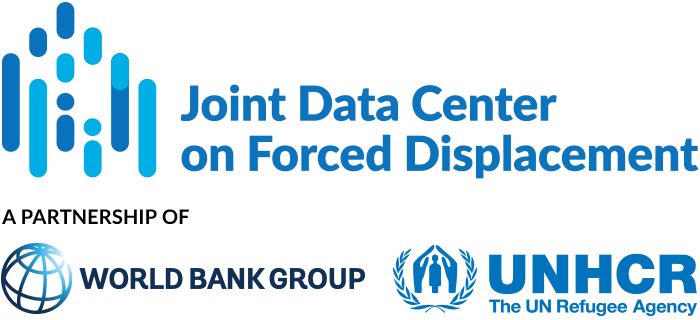This paper proposes a novel approach to measuring refugee self-reliance, grounded in global poverty measurement, that focuses on self-earned income. The measure captures the ability to meet physiological and basic material needs independently of aid.
A refugee is considered self-reliant if their self-earned income exceeds the locally relevant poverty line. Earned income includes wages from employment and earnings from self-employment, and excludes gifts (either in-kind or cash) from humanitarian agencies and other sources, as well as remittances from non-refugee family members. The self-reliance indicator is expressed as the average incidence of self-reliance among the refugee population. The ‘self-reliance gap’ measures the shortfall in refugee incomes, expressed as a fraction of the poverty line, needed to achieve self-reliance for all refugees. Refugee earned income is approximated by subtracting humanitarian assistance from refugee consumption, assuming negligible net savings and borrowing, while considering remittances as part of self-earned income.
The authors test this approach using 11 microdata sets covering refugees (and in most cases host communities) in Bangladesh, Chad, Colombia, Costa Rica, Ethiopia, Jordan, Kenya, Lebanon, Niger, West Bank and Gaza, and Uganda.
Main results:
- Poverty among refugees is high, especially in low-income countries. Refugee poverty exceeds 60% in all examined countries, reaching 75% in Ethiopia. Poverty incidence among refugees is lower in middle-income countries, varying from 50 percent in Kenya (a lower middle-income country) to 24 percent in Costa Rica (an upper -middle income country).
- Host community poverty is often high, sometimes exceeding refugee poverty rates. For example, in Kakuma, Kalobeyei, and Dadaab, host poverty is higher than refugee poverty.
- The aid received by poor refugees varies between countries. Poor refugees in Ethiopia receive 32% of the poverty line in assistance, while those in Niger receive only 9%. In Kenya and Jordan, refugees receive 17-18% of the poverty line, whereas in Costa Rica and Colombia, they receive only 2%.
- Aid reduces poverty among refugees significantly. The contribution to poverty reduction is greatest in Jordan, where refugee poverty reduces by almost half, from 59 to 32 percent. In contrast, the impact is minimal in Niger, with a reduction of 7 percentage points, and in Costa Rica and Colombia, with reductions of 2-3 percentage points.
- The efficiency of aid in reducing refugee poverty varies widely. In Chad and Niger, US$1,012 reduces poverty by 1 percentage point, while in Ethiopia, Colombia, and the West Bank and Gaza, three times more money is needed to achieve the same reduction.
- Refugees are generally less self-reliant than their hosts. In Uganda and Ethiopia, only 14-15% of refugees earn an income above the poverty line, compared to 75% and 63% of hosts, respectively. The gap in self-reliance is smaller in Costa Rica and Colombia.
- Self-reliance is higher in urban areas, such as Addis Ababa and Kampala, compared to camps. In Nairobi, where refugee work freedoms are restricted, self-reliance is noticeably lower. In Jordan, self-reliance is higher in the capital city, Amman, than in the camp-based settings of Azraq and Zaatari.
- There is significant variation in self-reliance across camps. Only 4% of refugees in Ethiopian camps are self-reliant, compared to 39% in Dadaab, Kenya. Self-reliance is lower in isolated camps, such as Azraq, compared to those near population centers, like Zaatari.
- Self-reliance is negatively correlated with aid, indicating that more aid is provided in areas with severe restrictions on refugees’ ability to work and earn a living.
- Self-reliance is far more likely to reduce refugee poverty than aid. Income earned by refugees exceeds aid received, challenging the common perception that refugees are passive recipients of aid. Additionally, despite significant amounts of aid being spend on refugees, aid is insufficient (on average) to bring refugee to or above the global poverty line. In low-income countries, refugee incomes need to increase by 62% to reach the poverty line, while aid would need to increase by 115%. In middle-income countries, refugee incomes need to increase by 17%, whereas aid would need to increase by 221%.
The analysis reveals that refugee self-reliance is influenced by several factors. Location and economic environment are key, with refugees in middle-income countries and urban, non-camp settings being more self-reliant due to greater economic opportunities. While some labor market restrictions do not significantly impact self-reliance, an inability to work severely impairs it. The analysis also demonstrates that aid and self-reliance are inversely correlated; higher aid levels are found where refugees are less self-reliant, and lower aid levels where they are more self-reliant.
The authors conclude that since aid and refugee self-earned incomes are substitutes, governments that encourage refugee self-reliance should receive more aid. This would allow reallocating resources from humanitarian to development purposes, benefiting both refugees and hosts. Refugees would gain financial autonomy and self-reliance, while hosts, who often face high poverty levels, would also benefit. Investments in the development potential of hosting regions would increase the incomes and self-reliance of both refugees and hosts.


